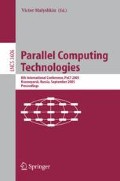Abstract
A parallel computational code is developed for the execution of the Proper Orthogonal Decomposition (POD) of turbulent flow fields in fluid dynamics. The POD is an analytically-founded statistical technique that permits the eduction of appropriately-defined modes of the flow from the background flow, allowing the determination of the coherent structures of turbulence. The computational aspects of the different phases of the computing procedure are analyzed and the development of the related parallel computational code is described. Computational tests corresponding to different computing domains and number of processors are executed on a HP-V2500 parallel computing system and the results are shown in terms of parallel performance of the different phases of the calculations separately considered and of the computational code in the whole.
Access this chapter
Tax calculation will be finalised at checkout
Purchases are for personal use only
Preview
Unable to display preview. Download preview PDF.
References
Alfonsi, G., Passoni, G., Pancaldo, L., Zampaglione, D.: A spectral-finite difference solution of the Navier-Stokes equations in three dimensions. Int. J. Num. Meth. Fluids. 28, 129 (1998)
Passoni, G., Alfonsi, G., Galbiati, M.: Analysis of hybrid algorithms for the Navier-Stokes equations with respect to hydrodynamic stability theory. Int. J. Num. Meth. Fluids. 38, 1069 (2002)
Speziale, C.G.: Analytical methods for the development of Reynolds-stress closures in turbulence. Ann. Rev. Fluid Mech. 23, 107 (1991)
Lesieur, M., Métais, O.: New trends in Large-Eddy simulation of turbulence. Ann. Rev. Fluid Mech. 28, 45 (1996)
Moin, P., Mahesh, K.: Direct Numerical Simulation: a tool in turbulence research. Ann. Rev. Fluid Mech. 30, 539 (1998)
Smagorinsky, J.: General circulation experiments with the primitive equations. Mon. Weather Rev. 91, 99 (1963)
Bardina, J., Ferziger, J.H., Reynolds, W.C.: Improved subgrid models for large-eddy simulation. AIAA Pap., pp. 80–1357 (1980)
Kraichnan, R.H.: Eddy viscosity in two and three dimensions. J. Atmos. Sci. 33, 1521 (1976)
Métais, O., Lesieur, M.: Statistical predictability of decaying turbulence. J. Atmos. Sci. 43, 857 (1986)
Yakhot, A., Orszag, S.A., Yakhot, V., Israeli, M.: Renormalization group formulation of large-eddy simulation. J. Sci. Comput. 4, 139 (1989)
Germano, M.: Turbulence, the filtering approach. J. Fluid Mech. 238, 325 (1992)
Spalart, P.R.: Direct simulation of a turbulent boundary layer up to Req »1410. J. Fluid Mech. 187, 61 (1988)
Passoni, G., Alfonsi, G., Tula, G., Cardu, U.: A wavenumber parallel computational code for the numerical integration of the Navier-Stokes equations. Parall. Comput. 25, 593 (1999)
Passoni, G., Cremonesi, P., Alfonsi, G.: Analysis and implementation of a parallelization strategy on a Navier-Stokes solver for shear flow simulations. Parall. Comput. 27, 1665 (2001)
Fischer, P.F., Patera, A.T.: Parallel simulation of viscous incompressible flows. Ann. Rev. Fluid Mech. 26, 483 (1994)
Cantwell, B.J.: Organized motion in turbulent flow. Ann. Rev. Fluid Mech. 13, 457 (1981)
Robinson, S.K.: Coherent motions in the turbulent boundary layer. Ann. Rev. Fluid Mech. 23, 601 (1991)
Lumley, J.L.: Stochastic tools in turbulence. Academic Press, London (1971)
Kosambi, D.D.: Statistics in function space. J. Indian Math. Soc. 7, 76 (1943)
Loéve, M.: Functions aleatoire de second ordre. C. R. Acad. Sci. Paris. 220 (1945)
Karhunen, K.: Zur spectral theorie stochastischer prozesse. Ann. Acad. Sci. Fenicae. A1, 34 (1946)
Pougachev, V.S.: General theory of the correlations of random functions. Izv. Akad. Nauk. SSSR, Ser. Math. 17, 1401 (1953)
Obukhov, A.M.: Statistical description of continuous fields. Trans. Geophys. Int. Akad. Nauk. SSSR 24, 3 (1954)
Sirovich, L.: Turbulence and the dynamics of coherent structures. Parts I-III. Quart. Appl. Math. 45, 561 (1987)
Berkooz, G., Holmes, P., Lumley, J.L.: The Proper Orthogonal Decomposition in the analysis of turbulent flows. Ann. Rev. Fluid Mech. 25, 539 (1993)
Bakewell, P., Lumley, J.L.: Viscous sublayer and adjacent wall region in turbulent pipe flows. Phys. Fluids. 10, 1880 (1967)
Aubry, N., Holmes, P., Lumley, J.L., Stone, E.: The dynamics of coherent structures in the wall region of a turbulent boundary layer. J. Fluid Mech. 192, 115 (1988)
Moin, P., Moser, R.D.: Characteristic-eddy decomposition of turbulence in a channel. J. Fluid Mech. 200, 471 (1989)
Sirovich, L., Ball, K.S., Keefe, L.R.: Plane waves and structures in turbulent channel flow. Phys. Fluids. A2, 2217 (1990)
Ball, K.S., Sirovich, L., Keefe, L.R.: Dynamical eigenfunction decomposition of turbulent channel flow. Int. J. Num. Meth. Fluids. 12, 585 (1991)
Webber, G.A., Handler, R.A., Sirovich, L.: The Karhunen-Loéve decomposition of minimal channel flow. Phys. Fluids. 9, 1054 (1997)
Press, W.H., Teukolsky, S.A., Vetterling, W.T., Flannery, B.P.: Numerical Recipes in Fortran 77. Cambridge University Press, Cambridge (1992)
Author information
Authors and Affiliations
Editor information
Editors and Affiliations
Rights and permissions
Copyright information
© 2005 Springer-Verlag Berlin Heidelberg
About this paper
Cite this paper
Alfonsi, G., Primavera, L. (2005). A Parallel Computational Code for the Education of Coherent Structures of Turbulence in Fluid Dynamics. In: Malyshkin, V. (eds) Parallel Computing Technologies. PaCT 2005. Lecture Notes in Computer Science, vol 3606. Springer, Berlin, Heidelberg. https://doi.org/10.1007/11535294_33
Download citation
DOI: https://doi.org/10.1007/11535294_33
Publisher Name: Springer, Berlin, Heidelberg
Print ISBN: 978-3-540-28126-9
Online ISBN: 978-3-540-31826-2
eBook Packages: Computer ScienceComputer Science (R0)

